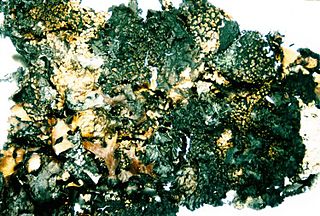William Alfred Weber was an American botanist and lichenologist. He was Professor Emeritus at the University of Colorado at Boulder and former curator of the University of Colorado Museum Herbarium.
Culbersonia is a fungal genus in the family Caliciaceae. This is a monotypic genus, containing the single foliose lichen Culbersonia nubila. This species, which grows on trees and rocks, is found in dry subtropical regions of the world, particularly in Africa and Central America.
Lethariella is a genus of fruticose lichens in the family Parmeliaceae. The genus was originally proposed as a subgenus of Usnea by Polish lichenologist Józef Motyka in his 1936 monograph of that genus. Norwegian botanist Hildur Krog elevated the taxon to generic status in 1976.

Cetrelia is a genus of leafy lichens in the large family Parmeliaceae. They are commonly known as sea-storm lichens, alluding to the wavy appearance of their lobes. The name of the genus, circumscribed in 1968 by the husband and wife lichenologists William and Chicita Culberson, alludes to the former placement of these species in the genera Cetraria and Parmelia.

Punctelia is a genus of foliose lichens belonging to the large family Parmeliaceae. The genus, which contains about 50 species, was segregated from genus Parmelia in 1982. Characteristics that define Punctelia include the presence of hook-like to thread-like conidia, simple rhizines, and point-like pseudocyphellae. It is this last feature that is alluded to in the vernacular names speckled shield lichens or speckleback lichens.
Chicita Frances Culberson is an American lichenologist.

Thamnolia is a genus of lichens in the family Icmadophilaceae. Members of the genus are commonly called whiteworm lichens.

Menegazzia terebrata is a species of foliose lichen found scattered across many continents, including North America, South America, Europe, Africa, and Asia.

Asahinea is a genus of lichenized fungi in the family Parmeliaceae. The genus has a widespread circumpolar distribution, and contains three species. The genus was circumscribed by the husband and wife lichenologist team William and Chicita F. Culberson in 1965, with Asahinea chrysantha as the type species. The genus name honours Japanese lichenologist Yasuhiko Asahina.

William Louis "Bill" Culberson was an American lichenologist.
Vermilacinia cerebra is a fruticose lichen that grows on trees and shrubs in the fog regions along the Pacific Coast of North America from the Channel Islands and mainland California near Los Angeles to southern Baja California, also occurring in South America in the Antofagasta Province of northern Chile. The epithet is in reference to the apical swollen lobes that resemble the cerebrum of the brain.

Yasuhiko Asahina was a Japanese chemist and lichenologist. The standard author abbreviation Asahina is used to indicate this person as the author when citing a botanical name.

Umbilicaric acid is an organic polyphenolic carboxylic acid made by several species of lichen. It is named after Umbilicaria. Umbilicaric acid is a tridepside, containing three phenol rings.
Bryoria hengduanensis is a species of lichen of the genus Bryoria. It was described as new to science in 2003 by lichenologists Li-Song Wang and Hiroshi Harada. It is found in the Hengduan Mountains of southern China, where it grows on twigs and branches in coniferous forests at elevations of 3,000–4,000 metres (9,800–13,100 ft). The Hengduan Mountains is a region of high Bryoria biodiversity, as 24 species are known from this area.
Cetrelia olivetorum is a species of fungus belonging to the family Parmeliaceae.

Punctelia hypoleucites, commonly known as the southwestern speckled shield lichen, is a species of foliose (leafy) lichen in the family Parmeliaceae. First formally described by Finnish botanist William Nylander as a species of Parmelia, it was transferred to the genus Punctelia in 1982. The lichen is found in Africa, North America, and South America, where it grows on the bark of both hardwood and coniferous trees. Its greenish-grey thallus is covered with tiny white pseudocyphellae – minute holes in the thallus surface that facilitate gas exchange. Some macroscopic features that help distinguish this species from other related members of the genus include the presence and the structure of the apothecia, the absence of asexual surface propagules, and the light brown color of the thallus undersurface. Chemically, the presence of lecanoric acid in the medulla and atranorin in the cortex help distinguish it from lookalikes.

Punctelia graminicola is a species of foliose (leafy) lichen in the family Parmeliaceae. It grows on rocks, and, less frequently, on bark in North America, South America, and East Africa. It has a blue-grey thallus measuring up to about 15 cm (6 in), covered with tiny pores called pseudocyphellae. Sometimes the lichen forms small lobes that project out from the surface. Fruiting bodies are uncommon in this species; if present, they resemble small cups with a brown internal disc measuring 3–10 mm (0.1–0.4 in) in diameter. A lookalike species, Punctelia hypoleucites, is not readily distinguishable from Punctelia graminicola by appearance or habitat alone; these species can only be reliably differentiated by examining the length of their conidia.

Cetrelia chicitae is a species of foliose lichen in the family Parmeliaceae. It is found in eastern Asia, North America, and Europe, where it grows on mossy rocks and tree trunks.
Geoffrey Charles Bratt was an Australian chemist and lichenologist.
Lichen products, also known as lichen substances, are organic compounds produced by a lichen. Specifically, they are secondary metabolites. Lichen products are represented in several different chemical classes, including terpenoids, orcinol derivatives, chromones, xanthones, depsides, and depsidones. Over 800 lichen products of known chemical structure have been reported in the scientific literature, and most of these compound are exclusively found in lichens. Examples of lichen products include usnic acid, atranorin, lichexanthone, salazinic acid, and isolichenan, an α-glucan. Many lichen products have biological activity, and research into these effects is ongoing.











